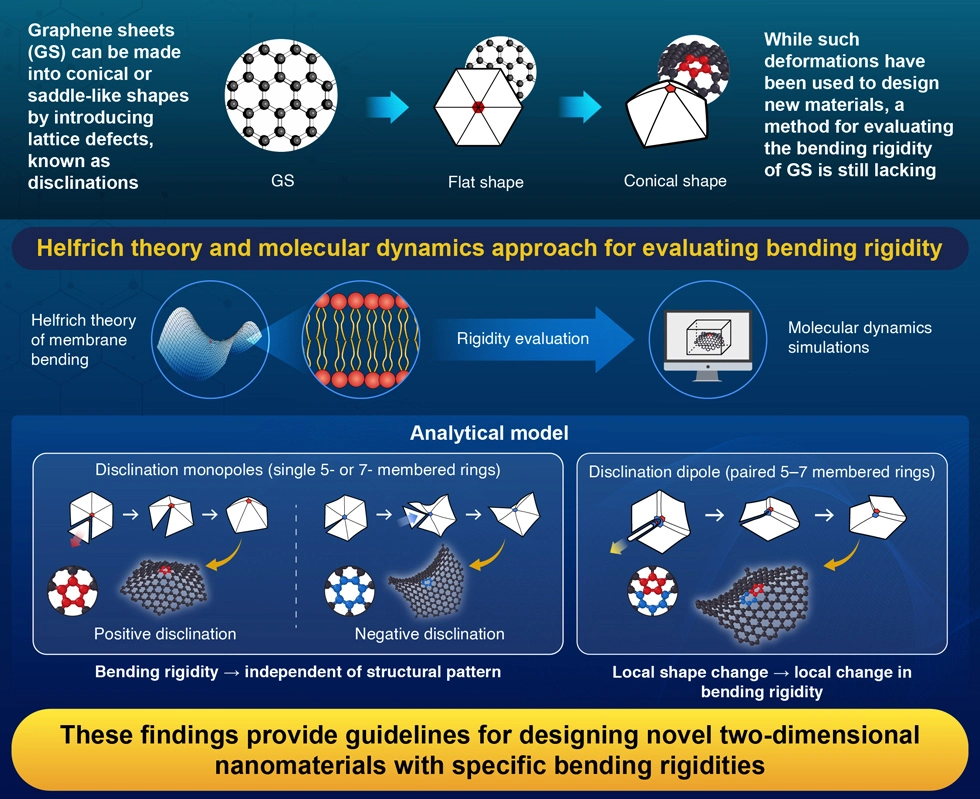The Helfrich theory of membrane bending, supported by molecular dynamics simulations, is a promising approach for evaluating mechanical properties of graphene sheets, report researchers from Institute of Science Tokyo. This hybrid approach allows direct evaluation of bending rigidities of graphene sheets, even with lattice defects, without requiring experimental tests, offering valuable insights for designing novel two-dimensional materials with tailored mechanical properties.
Quantitative Evaluation of Bending Rigidity in Graphene Sheets with Disclinations

Kunihiro et al. (2025) | Nanoscale
Graphene sheets (GS) are two-dimensional (2D) nano-carbon materials known for their remarkable flexibility, exceptional mechanical strength, and their ability to adopt different shapes. In particular, by introducing 5- or 7-membered rings into hexagon-shaped GSs, conical or horse-saddle-like shapes can be formed. Imagine a hexagonal piece of paper, which is divided into six equilateral triangles. Removing one triangle creates a 5-membered ring, which, when bent, forms a cone, while adding a triangle forms a 7-membered ring, producing a saddle-like shape. These ring structures are rotational-type lattice defects known as disclinations.
Disclinations have been utilized to develop various GS-based materials. For example, wave-shaped GSs called egg-tray graphene, which have periodic 5- or 7-membered rings, are known for their impact resistance. GSs with 7-membered rings show promise for use as nanosprings. These lattice defects have a significant effect on the local curvature and mechanical properties of GSs, especially their bending rigidity. While the bending rigidity of flat GSs has been well studied, that of GSs with disclinations remains poorly understood due to the variability introduced by deformations that make precise measurements difficult.
To address this gap, a research team led by Associate Professor Xiao-Wen Lei from the School of Materials and Chemical Technology at Institute of Science Tokyo (Science Tokyo), Japan, developed a new approach. "We have developed a new hybrid approach, combining molecular dynamics simulations with Helfrich theory of membrane bending," explains Lei. "This method allows for direct evaluation of bending rigidity of GSs with lattice defects directly from atomic configurations without requiring experimental tests." The team included graduate student Yushi Kunihiro and Professor Toshiyuki Fujii from Science Tokyo and Associate Professor Takashi Uneyama from Nagoya University. Their study was published online on July 21, 2025 in the journal Nanoscale.
The Helfrich theory of membrane bending describes the out-of-plane bending of 2D materials by modeling their curvature using energy considerations. Although originally developed for analyzing lipid bilayers of biological cells, this theory is also applicable to GSs due to geometric and mechanical similarities. However, solving this theory analytically is notoriously difficult. To simplify the analysis, the researchers applied molecular dynamics simulations.
Using this approach, the team analyzed four types of analytical models of GSs with disclinations: positive disclination monopoles (5-membered rings), negative disclination monopoles (7-membered rings), and connected and separated disclination dipoles that combine the monopoles. In connected dipoles, the positive and negative disclinations are placed together, while in separated dipoles, they are spaced apart at varying distances from separated dipoles.
The calculated bending rigidity values were within the reasonable range reported in previous studies, highlighting the validity of the approach. More notably, the results revealed, for the first time, differences in trends between GSs with monopoles and dipoles. Disclination dipoles showed similar bending rigidity once nonlinear effects were excluded. For dipoles, the combination of conical and saddle-shaped surfaces resulted in a local change in shape with a corresponding local change in bending rigidity. Furthermore, as the distance between disclinations increases, bending rigidity converges to a stable value, highlighting the importance of lattice defect density.
"Our findings not only offer a foundation for understanding mechanical properties of GSs with lattice defects but also insights for designing new GSs with specific bending rigidities and tailored mechanical properties," notes Lei. Overall, this study will accelerate the development of novel GS-based materials, such as nano-springs and impact-resistant graphene structures, leading to advanced 2D materials.
Reference
- Authors:
- Yushi Kunihiro1, Xiao-Wen Lei1, 2 *, Takashi Uneyama3, Toshiyuki Fujii1
- Title:
- A New Computational Approach for Evaluating Bending Rigidity of Graphene Sheets Incorporating Disclinations
- Journal:
- Nanoscale
- DOI:
- 10.1039/D5NR01102G
- Affiliations:
- 1School of Materials and Chemical Technology, Institute of Science Tokyo, Japan
2Precursory Research for Embryonic Science and Technology (PRESTO), Japan Science and Technology Agency (JST), Japan
3Department of Materials Physics, Graduate School of Engineering, Nagoya University, Japan






